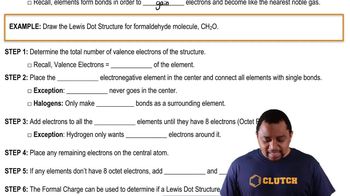A 20.0-mL sample of 0.200 M HBr solution is titrated with 0.200 M NaOH solution. Calculate the pH of the solution after the following volumes of base have been added: (e) 35.0 mL.
Ch.17 - Additional Aspects of Aqueous Equilibria
Chapter 17, Problem 44d,e
A 20.0-mL sample of 0.150 M KOH is titrated with 0.125 M HClO4 solution. Calculate the pH after the following volumes of acid have been added: (d) 25.0 mL. (e) 30.0 mL.
 Verified step by step guidance
Verified step by step guidance1
Step 1: Begin by calculating the initial moles of KOH in the 20.0 mL sample. Use the formula: \( \text{moles} = \text{volume (L)} \times \text{molarity (M)} \). Convert 20.0 mL to liters by dividing by 1000.
Step 2: Calculate the moles of HClO4 added for each volume (25.0 mL and 30.0 mL). Use the same formula: \( \text{moles} = \text{volume (L)} \times \text{molarity (M)} \). Convert the volumes from mL to liters.
Step 3: Determine the reaction between KOH and HClO4. The balanced chemical equation is: \( \text{KOH} + \text{HClO4} \rightarrow \text{KClO4} + \text{H2O} \). This is a 1:1 reaction, meaning one mole of KOH reacts with one mole of HClO4.
Step 4: For each volume of HClO4 added, calculate the remaining moles of KOH or HClO4 after the reaction. Subtract the moles of HClO4 from the initial moles of KOH to find the excess reactant.
Step 5: Calculate the pH based on the excess reactant. If KOH is in excess, calculate the concentration of OH⁻ ions and use \( \text{pOH} = -\log[\text{OH}^-] \) to find pH. If HClO4 is in excess, calculate the concentration of H⁺ ions and use \( \text{pH} = -\log[\text{H}^+] \).

Verified video answer for a similar problem:
This video solution was recommended by our tutors as helpful for the problem above.
Video duration:
4mWas this helpful?
Key Concepts
Here are the essential concepts you must grasp in order to answer the question correctly.
Titration
Titration is a quantitative analytical technique used to determine the concentration of a solute in a solution. It involves the gradual addition of a titrant (in this case, HClO4) to a solution of the analyte (KOH) until the reaction reaches its equivalence point, where the amount of titrant added is stoichiometrically equivalent to the amount of analyte present.
Recommended video:
Guided course

Acid-Base Titration
pH Calculation
pH is a measure of the acidity or basicity of a solution, defined as the negative logarithm of the hydrogen ion concentration. In titration problems, pH can be calculated at various points by considering the concentrations of the remaining acid or base after neutralization, as well as the resulting solution's characteristics, such as whether it is acidic, basic, or neutral.
Recommended video:
Guided course

pH Calculation Example
Neutralization Reaction
A neutralization reaction occurs when an acid reacts with a base to produce water and a salt. In this scenario, KOH (a strong base) reacts with HClO4 (a strong acid) to form water and potassium perchlorate. Understanding the stoichiometry of this reaction is crucial for determining the amounts of reactants and products at different stages of the titration.
Recommended video:
Guided course

Lewis Dot Structures: Neutral Compounds
Related Practice
Textbook Question
Textbook Question
A 20.0-mL sample of 0.150 M KOH is titrated with 0.125 M HClO4 solution. Calculate the pH after the following volumes of acid have been added: (a) 20.0 mL. (b) 23.0 mL.
Textbook Question
A 20.0-mL sample of 0.150 M KOH is titrated with 0.125 M HClO4 solution. Calculate the pH after the following volumes of acid have been added: (c) 24.0 mL.
Textbook Question
A 35.0-mL sample of 0.150 M acetic acid 1CH3COOH2 is titrated with 0.150 M NaOH solution. Calculate the pH after the following volumes of base have been added: (b) 17.5 mL.
Textbook Question
Consider the titration of 30.0 mL of 0.050 M NH3 with 0.025 M HCl. Calculate the pH after the following volumes of titrant have been added: (b) 20.0 mL (c) 59.0 mL.
